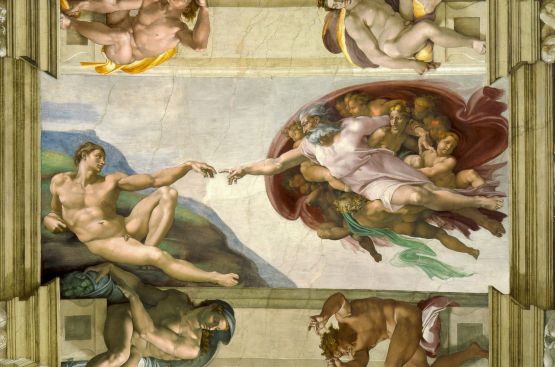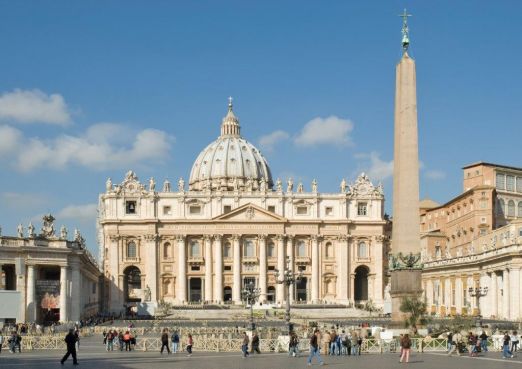Some forty meters long and 13 meters wide, it long sided walls have six windows that illuminate the chapel. Also under the reign of Sixtus IV, the walls were painted by celebrated artists of that period that included Botticelli, Ghirlandaio, Pinturicchio and Signorelli.
During the same period of the early history of the Sistine Chapel, Andrea Bregno created the marble fence that dives the chapel into two unequal parts: the chancel, the larger section reserved to the clergy , and the smaller nave area for the lay. He was also responsible for the pulpit on the right of the chancel. Often overlooked, the symbolic jewel-like pavement of the Sistine Chapel echoes the medieval past of the Cosmati. And from the floor, up the walls, to the ceiling and finally, the Last Judgement, there's a century's evolution of Italian art on display.
The History of the Sistine Chapel took a dramatic change of course under the patronage of Pope Julius II who almost single-handedly saved the papacy, going down in history as one of Rome's most important Popes. During his reign he launched a great program of works designed to rejuvenate the Vatican, one of the most important being the re-building of St. Peters Basilica whose magnificent modern-day form follows the initial designs of Bramante, architect to Julius II.
Pope Julius II was a great admirer of the young Michelangelo, and despite the celebrated falling out over his commission for the Popes funeral monument, he persuaded Michelangelo one way or the other to paint the ceiling of the Sistine Chapel. The original design for the ceiling was to be quite simple. Its legendary transformation into one of the greatest works of art of all time, was the result of the personal relationship forged between these two titanic figures of the Renaissance.
Pope Julius II was a shrewd judge of character and as described by the great historian Burckhardt, their relationship could not have been better suited for the task at hand. "Probably the alternations of merciless pressure with the frankest indulgences of kindness which characterized the relations between the Pope and Michelangelo were the means of obtaining more from him than any other treatment would have done".
And so the destiny of the Sistine Chapel was sealed. The cycle of frescoes for the Sistine Chapel had been established in the early history of the Sistine Chapel (1475-81) when great artists the likes of Botticelli followed themes of painting in accordance with the old medieval conception of the division of the world into three epochs: the first before God gave the Law to Moses; the second that of law given to Moses; and the third the period of grace dating from the birth of Christ.
With the second and third epochs already featured in the frescoes on the walls below, it became an obvious choice for Michelangelo to paint a series of frescoes translating the first epoch - before law. Hence the famous portrayals of the Creation, the birth of Eve, the Fall and so on. And so the gentle giant worked in complete isolation for four years on his splendid creation, while his rivals waited in the aisles hoping and willing him to fail.
Some 22 years after he had finished painting the ceiling of the Sistine Chapel, Michelangelo returned to write a new chapter in the history of the Sistine Chapel when he painted his "Last Judgement". The changes in fortune of Rome and the great artist over those 22 years are reflected in this very different style and adaptation by the artist, who he himself was seeking religious rejuvenation after his world had been thrown into chaos by the sacking of Rome in 1527.
Once completed the Sistine Chapel was immediately recognized as a national treasure that had to be preserved for the generations to come. And the history of the Sistine Chapel over the following centuries revolved around the preservation and constant renovation of Michelangelo's masterpiece. Only 50 years after the great cycle of frescoes was completed, it was discovered that soot from the had obscured the colors while infiltration of rainwater had caused cracks and salt incrustation on the paintings. Pope Pio IV conducted the first restoration of the Sistine Chapel (1566-72).
But, in the modern-day history of the Sistine Chapel the most dramatic intervention took place to literally save the frescoes of the Sistine Chapel. A complete restoration program began in 1980. And while the Art world was divided over whether the work should take place and possessed with the fear that the work would actually damage the frescoes, scientists carried out experiments on how best to treat the delicate paintings of the Sistine Chapel. The frescoes were washed with detergents to bring out their spectacular colors, and as Michelangelo had done, they were then covered with a transparent varnish to protect them.
Once the work was completed, the majority of art critiques celebrated the rejuvenation of Michelangelo's incredible work. Nowadays, the Sistine Chapel boasts special cold lights that illuminate without causing damage, and a computerized system constantly monitors the temperature and more importantly the humidity to secure that the history of the Sistine Chapel will continue beyond the 21st Century.









